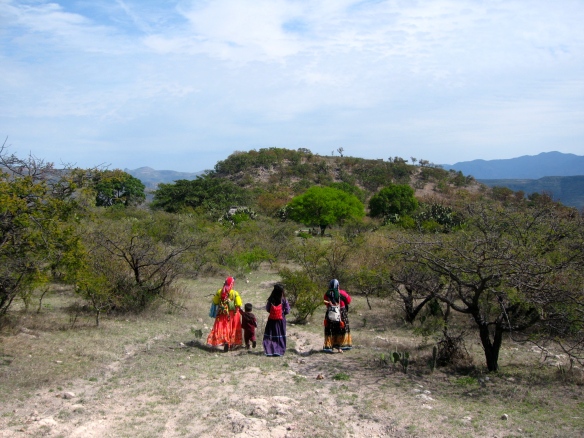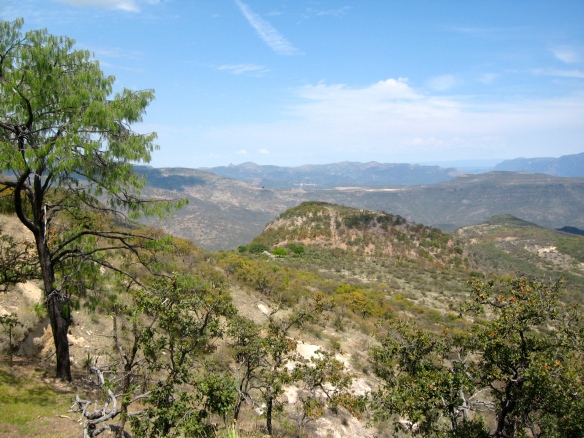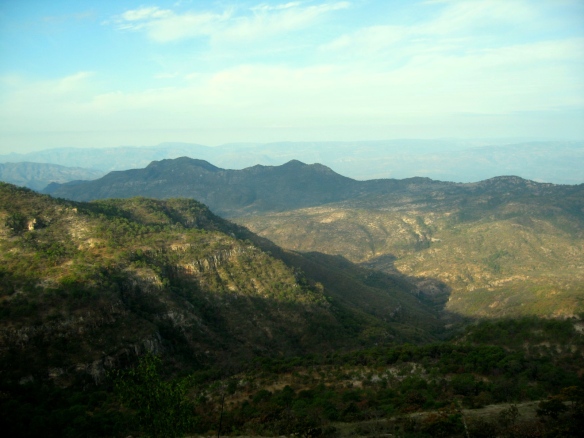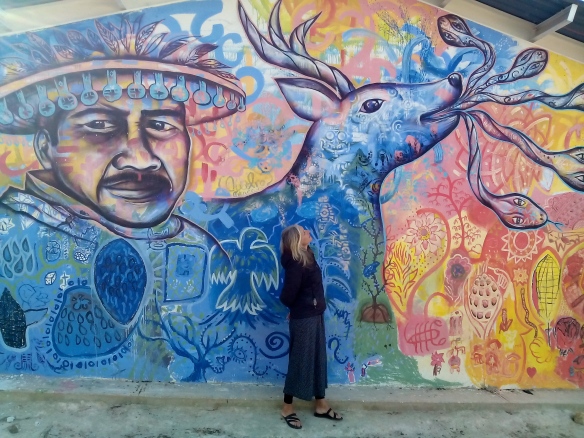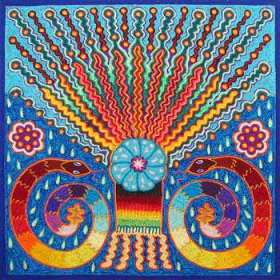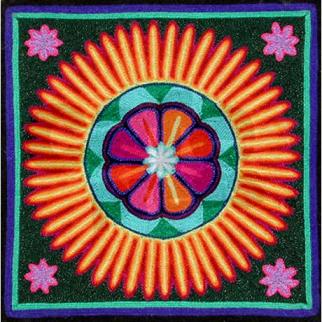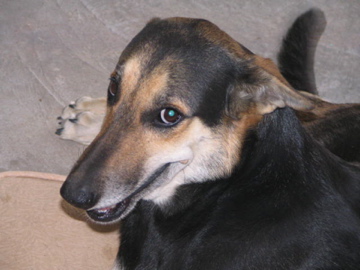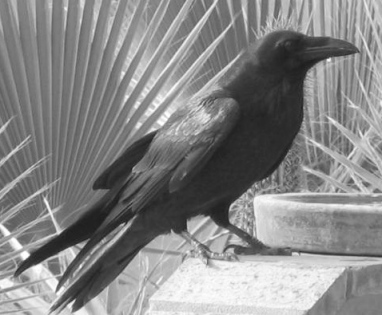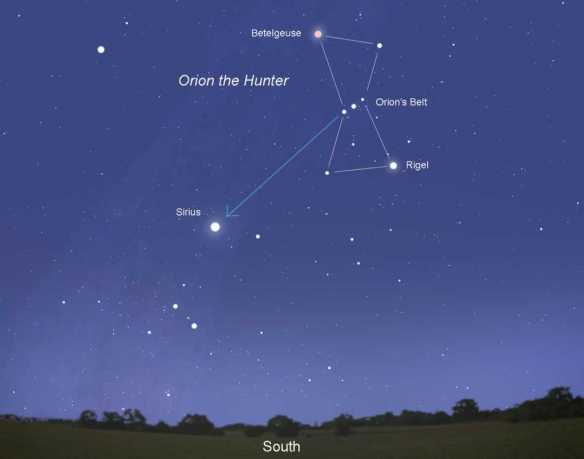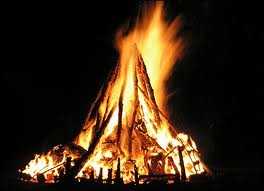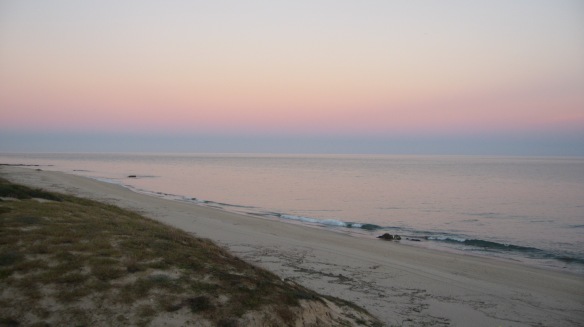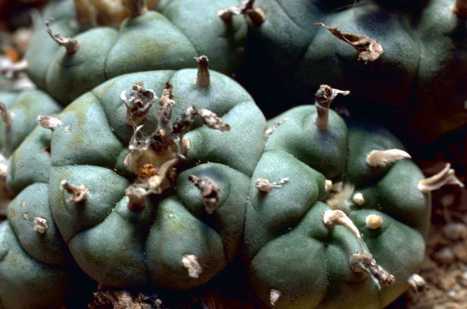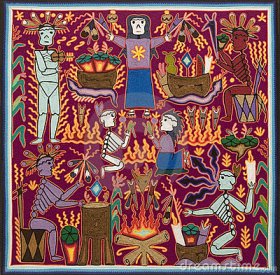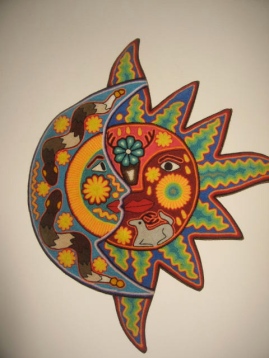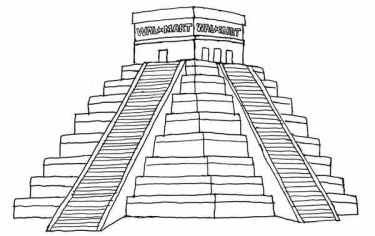The road began to narrow and the dirt changed from beige to the rusty hue of ocher. We hadn’t seen a house for over an hour when we arrived at a crossroads where a cluster of some six or seven buildings sat. I figured we must be getting close to our destination because two of the buildings were decorated with colorful murals of Huichol imagery. One was a portrait of a shaman next to a blue deer, on top of which many smaller images of peyote and other plants were painted. The shaman was recognizable from his characteristic sombrero adorned with eagle feathers and tassels along the outside edge. A second smaller building bore images of the ocean and the Huichol name for the ocean spirit “Tatei Haramara,” meaning Grandmother Ocean, in bright red.
 At our shaman Lupe’s request we stopped and Victor, Joel, and I got out to stretch our legs while Lupe went to look for someone. I quickly surveyed the area for a bathroom just in case. To my great consternation there was none that I could see. We took the obligatory tourist shots of one another in front of the larger mural before we were herded back into the van by Lupe.
At our shaman Lupe’s request we stopped and Victor, Joel, and I got out to stretch our legs while Lupe went to look for someone. I quickly surveyed the area for a bathroom just in case. To my great consternation there was none that I could see. We took the obligatory tourist shots of one another in front of the larger mural before we were herded back into the van by Lupe.
From here we turned left onto a side road that shot straight up the side of the mountain. The road narrowed and the terrain became more severe: cliffs rose steeply on our left and fell away dramatically to the right, the tops of trees growing below just barely reaching the road’s surface. In places small waterfalls cascaded down the dark grey cliff faces and gathered in small pools on the side of the road.
Before long the terrain flattened out and we were surrounded by stands of tall pines, whereas previously the forests were dominated by deciduous trees. Massive walls of beige and grey rock jutted proudly out of the surrounding terrain. Next thing I knew the van bounced and creaked into the diminutive village of San Jose Escuela. True to it’s name, a school (escuela) sits at the center of this gathering of ten or so homes and public buildings constructed of low-fire red brick. We parked next to one of the small single-story homes. A couple of wooden benches flanked the short central doorway. Behind the house several small pigs snorted and tousled in a rough dirt area fenced by gnarled wooden posts. Next to the house sat a smaller one-room building the size of some Americans’ walk-in closets. This was the general store.
Don Lupe, his son Memo, and Victor disembarked from the van while the rest of us waited. I assumed it was Mario they sought, the other shaman who was already in the sierra having arrived several days before. The men returned and loaded back into the van. Some words were exchanged in Wiratika and Victor fired up the van. I normally would have asked what was happening and where we were going, but between being up all night and my intestinal woes, I was uncharacteristically passive and decided to just go with the flow. We continued heading northeast on what resembled a rough track more than a road. Uneven and littered with large sharp rocks, it was only wide enough for one vehicle. I wondered what we’d do if we met someone coming the other way as there was no shoulder to speak of and in many areas where the side of the road ended the land dropped off precipitously. It wasn’t long before we met a couple of locals utilizing the preferred mode of transportation – burrows (donkeys). It occurred to me that this was the ideal way get around in the region and as our van creaked and swayed over the uneven, rock-strewn road I became convinced we’d either get a flat tire or a break an axle before long. As concern gathered as stress in my body, I felt my shoulders creep towards my ears, while held tight to the molded door handle. When I finally voiced my concerns about the van’s ability to sustain the abuse, they were dismissed offhand.
“You worry too much, Güera,” was Victor’s patronizing response. This became his mantra any time I expressed misgivings about something.
The countryside surrounding San Jose Escuela is dotted with small ranches where the Huichol grow corn, squash, and tomatoes, raise pigs, chickens, a few cows, and horses, mules, or burrows for transportation and plowing. The small clusters of buildings comprising each ranch, with their grey thatched roofs and stone walls, were hard to make out against the identically colored rock-strewn landscape. But at that time of year a gentle haze of purple and pink flowers adorning peach and apple trees planted along bordering stone fences helped to define their boundaries. I wondered how they were able to grow anything in such a rock strewn landscape.
 Eventually we ran out of road and when that didn’t stop our progress, a stand of trees finally did. It wasn’t quite noon, but the sun had gathered appreciable strength by the time we all tumbled out of the van and began hiking down a narrow foot path.
Eventually we ran out of road and when that didn’t stop our progress, a stand of trees finally did. It wasn’t quite noon, but the sun had gathered appreciable strength by the time we all tumbled out of the van and began hiking down a narrow foot path.
My sandals turned out not to be the best footwear for the hike, so when we reached a particularly steep section in the descent, I took them off and walked in my bare feet.
“Careful Güera,” warned Lupe’s daughter Angela. “There are spines and stickers on many of the plants here.”
In response to her warning, I increased the care with which I picked my way over the rocks. Nevertheless, soon a sharp sticker impaled the ball of my foot and made me cry out. I pulled up short to remove the offending spine. It turned out to be a very reticent seed head covered in so many spines that I couldn’t grab it with my fingers. I tried to use one of my sandals to flick it off, but after several painful attempts, I gave up and decided on another approach. Meanwhile Angela, her mother Olivia and Marianna looked on with concern.
“Don’t worry,” I said. “I’ll get it out.”
I looked around for a stick or a rock with a sharp edge. A thin piece of rock did the trick and I was soon on my way, choosing my path with even greater care.
As we reached the bottom of the valley, the terrain turned to sparse grass and sedge meadows dotted with low spiny trees, bushes, and the occasional nopal cactus. In the distance I could see the bright green canopy of a Mesquite tree and the deep green tops of a couple other tall trees. I stopped to put my sandals back on and take a few photographs. As I did Don Lupe, his son Memo, Angela, and Victor all passed me and continued on ahead.
Rancho Ciudad Juarez is where Olivia, Lupe’s wife grew up. Her parents, Don Juan and Leocadia, and her younger brother Juanito were there to greet our party. By the time I got there, however, everyone but Olivia had scattered, busying themselves with one thing or another and Victor was deep in conversation with Juanito.
Juanito exuded strength and confidence. He was dressed in traditional Huichol clothing – white cotton smock-shirt and pants with colorful piping along the edges. He wore an especially ornate shamans sombrero covered thickly in eagle feathers with a red fringe and blue tassels. Olivia sat on the ground with Jonathan, Marianna and Mario’s 18 month-old son in her arms. The others were off greeting their cousins, aunts, and uncles or making themselves busy with I knew not what.
The ranch consisted of two main structures – one larger than the other. The larger was a round-walled building with a stone foundation and grey low-fired brick walls with a roof that consisted of wood poles crossed with finer sticks and thatched over that with thick layers of long grasses greyed by the passage of time. The second building just beyond the first was a smaller rectangular affair made of the same type of grey bricks, but with a simpler pitched roof of large wood shingles. In the middle of the clearing that seemed to define the center of the ranch was a patch of earth grey with the ashes of many fires. Next to this were several flat rocks on which pots and pans sat. The soil next to these was stained burgundy, I presumed from the blood of an animal recently sacrificed.
 Aroused from their temporary slumber by the hike down the mountain, my intestines began once again to communicate an urgent need that I had no choice but to heed. I walked off into the desertscape, looking for a little privacy, ever watchful for snakes.
Aroused from their temporary slumber by the hike down the mountain, my intestines began once again to communicate an urgent need that I had no choice but to heed. I walked off into the desertscape, looking for a little privacy, ever watchful for snakes.
I returned feeling weaker yet and looked for somewhere to sit near Olivia under the wide-branched Mesquite tree. But before I could find a place to rest, Angela was at my side inviting me to join everyone in a circle around the now lit fire. This would be the first of many cleansing ceremonies to prepare us for our journey to Wirikuta.
Each of us was handed a small stick from one of the nearby trees. One at a time the shamans, Juanito, Lupe, and Don Juan, went from person to person and with chants and their muvieris (their power arrows to which eagle feathers are affixed) blessed us. But as Don Juan moved on to the next person after conducting his blessing of me, my stick seemed to jump out and grabbed onto his shirt. He pulled up, looked me sternly in the eye, and backing up slightly, unhooked himself before moving on again. I was mortified and wondered just what had happened. It seemed as though my stick acted of its own accord. Granted I was not feeling well and my stick was covered in little barbed hook-like projections, but I couldn’t help but think, as I knew the Huichol would, that this was not an insignificant occurrence. I couldn’t fathom what it could possibly mean though and wondered if anyone else who might be able to tell me had witnessed it.
The blessings completed we each rubbed our sticks over our bodies to cleanse ourselves of negative energy and then offered it to Tatewari, Grandfather Fire, who would purify it and us. Once we’d all put our sticks in the fire, the circle of people broke up and everyone returned to their business. My head spun slightly with weakness and confusion and I turned to find somewhere to sit down.
Before I could sit down though, Angela approached me once again.
“How are you feeling Güera?” she asked, genuinely concerned.
“A bit weak,” I admitted, “but I’m sure I’ll be fine.”
“You know, my grandfather is a highly respected shaman. Would you like him to do a healing for you?”
From my previous experience with her father Lupe, I had an idea of what a healing consisted of and figured that anything that might help rid me of the demon that was tearing at my insides was worth a try.
“Yes, please,” I responded, “that sounds like a good idea.”
Momentarily, Angela returned with her grandfather and introduced me as “La Güera.” In response to Don Juan’s curious expression, she laughed and admitted she didn’t know my real name.
“My Mexican friends call me Alba,” I said, holding out my hand in greeting.
Don Juan is a man I estimated to be in his mid to late fifties. Like the rest of the men, he was dressed in traditional Huichol clothing. On his head he wore a relatively plain, but new-looking straw sombrero with three colorful pompoms affixed along the upper portion of the brim where they were barely visible. I was surprised by the simplicity of his sombrero, that it featured neither eagle feathers nor the tassels that adorn most shamans’ hats. Similarly, on his feet, in contrast to the heavy-soled, woven leather sandals (called huaraches) that most Huichol wear, he wore beige construction boots. His physical appearance was one of contrasts as well – I detected both a softness exemplified by his light brown skin and an edgy sharpness expressed in his intense dark eyes and long hawkish nose. Among the Huichol, shamans are considered to be the embodiment of the eagle spirit, able to sore high with vision that extends around the world. Interesting then that in many ways Don Juan resembles an eagle.
The incident with the stick, while I knew was not forgotten, neither was it acknowledged nor did it stop him from his task. In short order, he invited me to lay down on a blanket that Angela placed on the ground under the Mesquite tree and told me to relax and breath normally. I lay back, the dark branches of Mesquite spread out above me, and closed my eyes.
Stay tuned for the next installment of Güera in Wirikuta.

